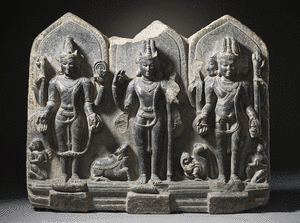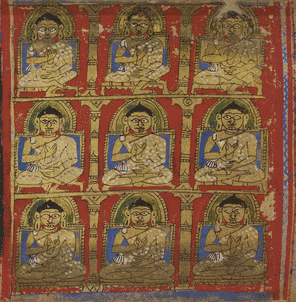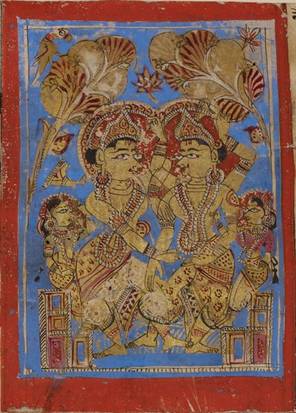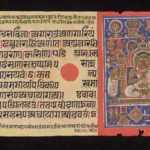Article: Jain Purāṇas
The Jain Purāṇas centre on ‘Jain Universal History’ or the lives of the 63 śalākā-puruṣas or mahā-puruṣas – ‘great men’. Meaning literally ‘the ancient [scriptures]’ in Sanskrit, the Purāṇas form a group of religious texts. The term purāṇa is more common among Digambaras, while Śvetāmbaras tend to use the term caritra – ‘biography’.
As a religious minority living within a largely Hindu society, the Jains have often responded to developments in Hindu India with works that have a distinctly Jain perspective. The Jain Purāṇas emerged to parallel the Hindu Purāṇas, which began to arise some centuries before the Common Era. The Jain versions, the earliest of which dates from the first centuries of the Common Era, demonstrate some similarities to Hindu Purāṇas in their narrative framework and subject matter. In contrast to the Hindu versions, however, the Jain texts were created by named authors and reflect key Jain religious beliefs, including karma.
Composed in a variety of languages, Jain purāṇas can be roughly classified into three groups. The first deals with the lives of just one or a small number of great men. They include the biographies of individual Jinas and the eighth Baladeva, Vāsudeva and Prati-vāsudeva triad, which forms the Jain versions of the Rāmāyaṇa, an epic poem. The second type recounts the life stories of all the great men. The final category of māhātmyas describes particular holy sites of pilgrimage.
Hindu Purāṇas
The original Purāṇas are an important body of mostly religious literature in Hinduism, reportedly meant for those groups in society to whom Vedic scripture was prohibited. These were women and the lower classes. The importance of this set of works can be seen in their occasional title of the ‘fifth Veda’.
Most of these Hindu Purāṇas developed over a period of several centuries. Although they are a class of Hindu religious literature, the Purāṇas are extremely diverse in content. They have been described as the most important textual sources for the study of ‘popular’ forms of Hinduism.
The Hindu Purāṇas share certain characteristics regarding their subject matter, setting and form.
Tradition cites five subjects to be dealt with in a purāṇa – purāṇa-pañca-lakṣaṇa. These are:
- creation
- the cyclical destruction and recreation of the world
- dynasties of the gods
- dynasties of kings
- lives of the forefathers of all humans.
The narration of a purāṇa takes place in the forest and takes the form of a dialogue between bards and sages, who report what they heard from other sages, kings and gods. A great number of purāṇas are known, and the most common categorisation is in the table.
|
Groups of purāṇas |
Sanskrit title |
Authority and examples |
|---|---|---|
|
18 major purāṇas |
mahā-purāṇas |
The most authoritative purāṇas, including the:
|
|
18 secondary purāṇas |
upa-purāṇas |
Of lesser authority, such as the Viṣṇudharmottara-purāṇa. |
Apart from these purāṇas proper, other texts are also considered to be purāṇic literature. Such a category is, for instance, the māhātmya. Literally meaning ‘greatness’, māhātmya texts describe the ‘greatness’ of a pilgrimage site or a deity. Māhātmyas are often incorporated into a larger purāṇa. The Devī-māhātmya, for instance, describes the ‘greatness’ of Devī, the Goddess in her many manifestations, and is included in the Mārkaṇḍeya-purāṇa.
Jain ‘counter tradition’
When purāṇic Hinduism grew ever more popular, the Jains began to compile a ‘counter tradition’ (Jaini 1993) of literature. Monks and poets composed purāṇas, offering a Jain alternative to the Hindu versions. The subject of the Jain Purāṇas are the lives of the śalākā-puruṣas or mahā-puruṣas – ‘great men’ – collectively labelled ‘Jain Universal History’.
Though there is relatively little trace in the extant canonical texts of most purāṇic stories, all Jain sects consider them to have been part of the Pūrvas. The Pūrvas formed a section of the original canon, passed down from the early disciples of the 24th Jina Mahāvīra, but were lost in the first centuries after Mahāvīra. As Digambaras consider the entire original canon to be lost and do not accept the authority of the Śvetāmbara scriptures, they accord the purāṇas the status of a secondary canon.
The term purāṇa is used more often by Digambara authors, whereas Śvetāmbaras tend to prefer the term caritra – ‘biography’ – for texts dealing with the same content and composed in a similar style. Some authors use both terms. Jain purāṇas are generally named after the highest-ranking ‘great man‘ who features in that purāṇa.
Similarities between Jain and Hindu Purāṇas
As a ‘counter tradition’, the Jain Purāṇas seem to mirror deliberately the Hindu Purāṇas in several aspects. These relate to the setting and subject.
Narrative setting
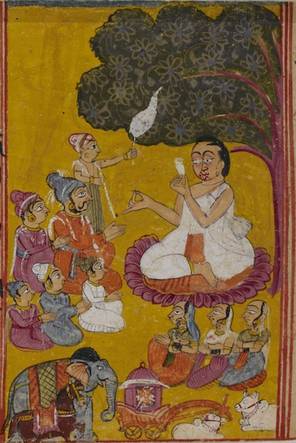
Indrabhūti Gautama preaches
Image by British Library © CC0 1.0 (Creative Commons Public Domain)
As in the Hindu Purāṇas, a Jain Purāṇa generally does not immediately commence with the main story, after which it is named. Parallel to the Hindu setting of bards and distinguished sages who are in the forest for a ritual, the Jain Purāṇas have their own specific sacred narrative setting, lending more authority to the story.
In the Jain texts, this setting is the samavasaraṇa or ‘universal assembly’ of Mahāvīra. King Śreṇika, the principal ruler who attends Mahāvīra’s universal assembly, asks about a particular great man. Indrabhuti Gautama, the Jina‘s first disciple, answers by telling the story.
Subject matter
Most Jain Purāṇas appear to mimic the five subjects of a Hindu Purāṇa. This means they include often seemingly superfluous descriptions of the:
- universe and time
- rise of the Kulakaras – ‘patriarchs’ – who guided humanity as conditions in the present period of time began to degenerate
- biography of the first Jina, Ṛṣabhanātha or Lord Ṛṣabha.
The last of these background themes deals with how Ṛṣabha created order in society and generated the different epic royal lineages within which the other great men are born.
Differences between Jain and Hindu Purāṇas
Although the Jain Purāṇas are similar to the Hindu Purāṇas in some ways, they differ in significant respects, namely regarding authorship and the embedding of Jain beliefs in the tales.
Authorship
The Hindu Purāṇas are generally attributed to the mytho-legendary author Vyāsa, who is also considered to be the author of the epic Mahābhārata and compiler of the Vedas. In reality, however, they were compiled over periods of many centuries by several anonymous authors and redactors.
The Jain Purāṇas, on the other hand, were composed by one or a few identifiable authors at specific points in time. As a result the Jain Purāṇas are less encyclopaedic and more structured than their Hindu counterparts.
Jain doctrine of karma
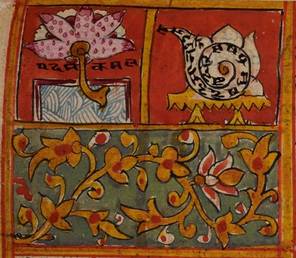
Plants and two-sensed beings
Image by British Library © CC0 1.0 (Creative Commons Public Domain)
The Jain Purāṇas, and Jain narrative literature in general, have been described as a means through which Jain authors could spread their ideology. Contrary to what one might expect in view of this, passages expounding the Jain doctrine are generally few in these texts. They typically occur when a protagonist encounters a muni and function as a pause in the narrative, rather than serving a strictly ideological purpose.
More important is the indirect way in which the central Jain doctrine of karman is explained through the Jain Purāṇas in the many stories of the previous and future births of the main characters. Up to ten previous births are narrated for some characters, demonstrating how the power of karman crosses multiple lifetimes and how a soul may become a mahā-puruṣa.
Literary forms
Jain Purāṇas have been composed in various languages, ranging from the classical literary languages of Sanskrit, Prakrit and Apabhraṃśa to vernacular languages such as Kannada, Gujarati and Hindi.
Jain purāṇas may be divided into three kinds of tale. The first type follows the pattern set in the earliest known purāṇa, which is a version of the Sanskrit epic poem of the Rāmāyaṇa. Texts in this category focus on just one or a few ‘great men’.
The second type of purāṇa is the mahā-purāṇa, which describes the lives of all the mahā-puruṣas – great men.
The third type groups together māhātmyas, which describe the ‘greatness’ of particular pilgrimage sites.
Purāṇas about individuals and epic enmities
The earliest available Jain Purāṇa is the Paümacariyam – Deeds of Padma – in Māhārāṣṭrī Prakrit. Composed by Vimala-sūri, it is in effect a Jain version of the popular epic Rāmāyaṇa, and dates from the fifth century at the latest. The tale takes its name from the protagonist Rāma, who is here called Padma. He and the main characters of this story – his brother Lakṣmaṇa and their enemy Rāvaṇa – are the eighth Baladeva, Vāsudeva and Prati-vāsudeva of this time period. The tale of Rāma or Padma was very popular and well known among Jains.
Another popular group within this type of Jain purāṇas are those called Harivaṃśa-purāṇas – Purāṇa of the Hari Dynasty – which focus on the life of the ninth Vāsudeva, Baladeva and Prati-vāsudeva. These are, respectively Kṛṣṇa, his brother Balarāma and their enemy Jarāsandha. These Jain Harivaṃśa-purāṇas also include the biography of the 22nd Jina Neminātha or Lord Nemi, who is the cousin of Kṛṣṇa. Hence they are often named Neminātha-caritras or variants, after Nemi. The earliest Harivaṃśa-purāṇa was composed by Jinasena Punnāṭa in 783.
Purāṇas dealing with one of the great men are very numerous. They include, for instance, the:
- Śāntinātha-purāṇa – Purāṇa of Śāntinātha – about the 16th Jina Śāntinātha or Lord Śānti, by Śubhacandra in the 17th century
- Munisuvratasvāmi-caritra – Biography of Lord Munisuvrata – about the 20th Jina Munisuvratanātha or Lord Munisuvrata, by Candra-sūri in the 12th century.
Jain mahā-purāṇas

Birth and marriage of Ṛṣabha
Image by Victoria and Albert Museum © V&A Images/Victoria and Albert Museum, London
Aside from purāṇas which narrate the lives of one or a few of the śalākā-puruṣas, Jain authors also created a category called mahā-purāṇa – ‘great purāṇa’ – echoing the Hindu term. In the Jain context, a mahā-purāṇa narrates the lives of all the mahā-puruṣas.
The earliest among these is the Caüppaṇṇa-mahā-purisa-cariya – Deeds of the 54 Great Men – by the Śvetāmbara sage Śīlāṅka (868–89). In Śīlāṅka’s categorisation, the nine Prati-vāsudevas are not considered mahā-puruṣas, hence the reduced number of 54 instead of the more traditional 63. Though Śīlāṅka’s was the earliest, his narration is by no means the most influential.
The most famous and authoritative Jain mahā-purāṇa was composed in the ninth century by the celebrated Digambara scholar Jinasena, teacher of the great Rāṣṭrakūṭa ruler Amoghavarṣa I. Jinasena was unable to finish the entire mahā-purāṇa so his chapters cover only the life of the first Jina Ṛṣabhanātha or Lord Ṛṣabha and his son Bharata, the first Cakravartin. It is therefore named Ādi-purāṇa – Purāṇa of the First [Jina].
The Ādi-purāṇa was supplemented with the Uttara-purāṇa – Purāṇa of the Remaining [Great Men] – by Jinasena’s pupil Guṇabhadra. These two compositions together bear the full title Triṣaṣṭi-lakṣaṇa-śrī-mahā-purāṇa-saṅgraha – Compendium of the Noble Mahā-purāṇa of the Characteristics of the 63 [Great Men]. Guṇabhadra also calls the text an itihāsa – ‘traditional history’ – and a dharma-śāstra – ‘law-book’. Moreover, as it also serves as a ritual manual, it therefore exhibits some encyclopaedic characteristics, similar to some of the Hindu Purāṇas.
Nowadays, the best-known mahā-purāṇa is the Triṣaṣṭi-śalākā-puruṣa-caritra – Deeds of the 63 Great Men – by the Śvetāmbara Hemacandra. Written in the 12th century, it was the first mahā-purāṇa to be fully translated into English, and took Helen Johnson 31 years to publish, beginning in 1931.
Māhātmyas
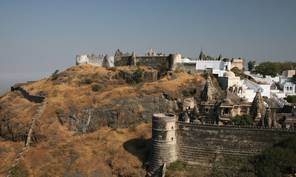
Shatrunjaya temple compounds
Image by Ark in Time – Asaf Braverman © CC BY-NC-SA 2.0
Jain authors also composed a few māhātmyas describing the ‘greatness’ of particular pilgrimage sites.
The most famous is the Śatruñjaya-māhātmya by Dhaneśvara-sūri, written around 1100, glorifying the best-known Śvetāmbara site, Mount Śatruñjaya in Gujarat.
Aside from this, there is also the Sammedaśikhara-māhātmya by Devadatta (1800), which celebrates Mount Sammeta in Bihar, where no fewer than 20 out of the 24 Jinas of the present time period are said to have attained enlightenment.
These māhātmyas depict when and how these holy places came to be sacred, through association with one or more Jinas. Whereas Hindu māhātmyas are generally incorporated into a larger purāṇa, Jain māhātmyas are individual compositions.
Reading
- The Purāṇas
Ludo Rocher - A History of Indian Literature series; series editor Jan Gonda; volume II: 3 'Epics and Sanskrit Religious Literature'
Otto Harrassowitz; Wiesbaden, Hesse, Germany; 1986
- Harivaṃśapurāṇa: Ein Abschnitt aus der Apabhraṃśa-Welthistorie "Mahāpurāṇa Tisaṭṭhimahāpurisa-guṇālaṃkāra" von Puṣpadanta, als beitrag zur kenntnis des apabhraṃśa und der universalgeschichte der Jainas
Puṣpadanta - translated and edited by Ludwig Alsdorf
Alt- und Neu-Indische Studien series; volume 5
Friederischsen, De Gruyter & Co; Hamburg, Germany; 1936
- Caupannamahāpurisacariaṃ by Ācārya Śrī Śīlāṅka
A. M. Bhojak - Prakrit Text Society; Ahmedabad, Gujarat, India; 1961
- Śīlāṅkas Cauppaṇṇamahāpurisacariya: Ein Beitrag zur Kenntnis der Jaina-Universalgeschichte
Klaus Bruhn - De Gruyter; Hamburg, Germany; 1954
- ‘The Satrunjaya Mâhâhātmyam: A contribution to the history of the Jainas by Professor Albert Weber’
James Burgess - Indian Antiquary
volume 30
1901
- ‘An Overview of the Jaina Purāṇas’
John E. Cort - Purāṇa Perennis: Reciprocity and Transformation in Hindu and Jaina Texts
edited by Wendy Doniger
State University of New York Press; New York, USA; 1993
- ‘The Jain Rāmāyaṇa-Purāṇa: Paümacariyaṃ-Padmacarita-Paümacariu’
Eva De Clercq - Epics, Khilas and Purāṇas: Continuities and Ruptures
edited by Petteri Koskikallio
Proceedings of Dubrovnik International Conference on the Sanskrit Epics and Puranas series; series editor Mislav Ježić; volume 3
Croatian Academy of Sciences and Arts; Zagreb, Croatia; 2005
- Purāṇa Perennis: Reciprocity and Transformation in Hindu and Jaina Texts
Wendy Doniger - State University of New York Press; Albany, New York, USA; 1993
- Mahāpurāna: Uttar Purāna of Acārya Gunabhadra
- translated and edited by Pannalal Jain
Jñānapītha Mūrtidevi Jaina granthamālā: Sanskrit grantha series; volume 14: II
Bhāratīya Jñānapītha; Kāshi, Uttar Pradesh, India; 1954
- 'Ādipurāṇa of Āchārya Jinasena'
- translated and edited by Pannalal Jain
Jñānapīṭha Mūrtidevī Jain granthamālā: Sanskrit grantha series; volume 8–9: I
Bhāratīya Jñānapītha; Kāshi, Uttar Pradesh, India; 1963–1965
- ‘A Purāṇic Counter Tradition’
Padmanabh S. Jaini - Purāṇa Perennis: Reciprocity and Transformation in Hindu and Jaina Texts
edited by Wendy Doniger
State University of New York Press; New York, USA; 1993
- Ueber das Çatrunjaya Mâhâtmyam: Ein Beitrag zur Geschichte der Jaina
Albrecht Weber - Abhandlungen für die Kunde des Morgenlandes series; volume 1: 4
Deutsche Morgenländische Gesellschaft / Brockhaus; Leipzig, Saxony, Germany; 1858
-
Publication information Title Doctrinal passages of the Jain Rāmāyaṇas Author Eva De Clercq Editor Colette Caillat and Nalini Balbir Journal or book or series Jaina Studies, Papers of the XIIth World Sanskrit Conference series series editor Petteri Koskikallio and Asko Parpola; volume 9 Publication details Motilal Banarsidass, Delhi, India; 2008; New Delhi, India Comments Pages 87 to 99 One of ten papers on Jain literary topics delivered at the 12th World Sanskrit Conference, held in Helsinki, Finland from 13 to 18 July 2003. The conference was organised by the International association of Sanskrit Studies and the Institute of Asian and [...]
Links
- Types of ‘Great Men’
-
Information about the types of śalākā-puruṣas or mahā-puruṣas – ‘great men’ – in traditional Jain stories is provided by the Shrimad website. This information is not considered to be correct by scholars but represents a popular contemporary understanding of the categories of the 'great men'.
- Maṇḍala of Mahāvīra
-
The Museum of Fine Arts in Boston, USA, provides a zoomable photograph of a 16th-century meditation diagram. This colourful maṇḍala depicts the samavasaraṇa – universal assembly – of an omniscient Jina, in which he preaches to all sentient beings. In the centre is the 24th Jina Mahāvīra, preaching to:
- members of the fourfold community in the corners
- pairs of natural enemies who are at peace during the sermon, such as the lion and antelope.
Numerous auspicious symbols and mantras enhance the powerful spiritual qualities of the maṇḍala.
http://www.mfa.org/collections/object/jain-mandala-with-varddhamana-in-the-center-22429
- Sūri-mantra-paṭa
-
The Virginia Museum of Fine Arts presents this colourful sūri-mantra-paṭa dating to the second half of the 17th century. Click on the picture to view the image in more detail.
Sūri-mantra-paṭas are yantras used only by Śvetāmbara Mūrti-pūjak monks, especially the Kharatara-gaccha and the Tapā-gaccha, when they reach the rank of sūri. Typically, this example depicts Indrabhūti Gautama, the first disciple of Mahāvīra, in the centre.
- Altarpiece of Ṛṣabha and other Jinas
-
The Art Institute in Chicago, Illinois, USA, provides a zoomable image of Ṛṣabhanātha or Lord Ṛṣabha, the first Jina, surrounded by all the other Jinas. The brass altarpiece is finely made, depicting the Jinas sitting in meditation, with symbols of high spiritual and worldly status emphasising their positions at the pinnacle of the Jain faith. The photograph can be enlarged to see more detail.
http://www.artic.edu/aic/collections/artwork/142507?search_no=2&index=10
- Ṛṣabha, attendants and Jinas
-
This black stone figure of the first Jina, Ṛṣabhanātha or Lord Ṛṣabha, dates from the 12th century. The standing image is surrounded by the other 23 Jinas and his yakṣa and yakṣī – attendant deities.
The photograph can be enlarged and zoomed in to examine the piece in more detail. The photo and a short audio description are on the website of the auction house Christie's.
- Parents of a Jina
-
Stone relief of the parents of a Jina. This somewhat damaged sculpture comes from Gwalior, Madhya Pradesh, and shows a richly bejewelled king and queen with attendants. The Metropolitan Museum of Art in New York, USA, provides this black and white photograph.
http://www.metmuseum.org/Collections/search-the-collections/60005089
- Jina’s parents
-
The Asian Art Museum in San Francisco, USA, provides a photograph of a sculpture of the parents of a Jain teacher or Jina. From Uttar Pradesh, this stele was carved in the tenth century CE.
http://searchcollection.asianart.org/view/objects/asitem/nid/11263
- Jina with yakṣa and yakṣī
-
Dating from the 12th to 13th centuries, this metal figure of an unidentified Jina is flanked by his attendant deities, known as śāsana-devatās – ‘deities of the teaching’. They have not attained final liberation and are able to intervene in human affairs, unlike a Jina. By convention the male yakṣa is presented on the Jina's right side and the female yakṣī on his left. This photograph is on the website of the British Museum in London.
https://www.britishmuseum.org/collection/object/A_1914-0218-8
- Mahābhārata – English translation
-
The Internet Archive offers Romesh Dutt's 1898 translation of the Sanskrit epic poem Mahābhārata into English verse. One of the Hindu accounts of the poem, it can be read online or downloaded in various formats.
- Theory of Karma
-
Anop R. Vora briefly outlines the concept of karma within the Jain religion. The information is provided by the Jainism Literature Center, associated with the Faculty of Arts and Sciences at Harvard University.
http://www.fas.harvard.edu/~pluralsm/affiliates/jainism/article/karma.htm
- Views of Shatrunjaya temples
-
Collection of photographs of the temple-city of Mount Shatrunjaya. The pre-eminent Śvetāmbara pilgrimage site, Shatrunjaya has nearly a thousand temples. The main temple is dedicated to Ṛṣabha, the first Jina, often called Ādinātha or First Lord. These photographs are presented by Professor Frances W. Pritchett of Columbia University in New York.
- Shatrunjaya photographs
-
This set of photographs on Flickr by amaury_217 of the holy site of Mount Shatrunjaya was taken in April 2010.
http://www.flickr.com/photos/amaury_217/sets/72157624236203157/with/4734828559/
- Worship of R̥ṣabha
-
The Los Angeles County Museum of Art provides an illustrated manuscript page showing the worship of R̥ṣabhanātha or Lord R̥ṣabha, the first Jina, at Mount Shatrunjaya. Shatrunjaya is a major pilgrimage site in Gujarat, especially for Śvetāmbara Jains.
- +
- aAbhavya
- aAbhinandana
- aAbhiṣeka
- aĀcāra
- aĀcārāṅga-sūtra
- aĀcārya
- aAchalbhrata
- aAḍhāī-dvīpa
- aAdharma
- aAdho-loka
- aAdhyayana
- aAdvaita Vedānta
- aĀgama
- aAghātīya
- aAghātīya-karman
- aAgnibhuti
- aAgra
- aĀhāra
- aAhiṃsā
- aAhimsa Day
- aAjita
- aAjīva
- aAkampit
- aĀkāśa
- aAkbar the Great
- aAkṣaya-tṛtīyā
- aAlauddin Khalji
- aAlbert Einstein
- aAllah
- aAlms
- aĀlocanā
- aAloka-ākāśa
- aAmāri
- aAmbikā or Kūṣmāṇḍinī
- aAnagāra
- aAnanta
- aAnarthadaṇḍa
- aAnaśana
- aAnekānta-vāda
- aAṅga
- aAniconism
- aAnojjā
- aAntarāla
- aAntarāya-karma
- aAṇu
- aAṇu-vrata
- aAnukampā
- aAnuprekṣā
- aAnusvāra
- aApabhraṃśa
- aAparigraha
- aAra
- aĀrambha
- aĀrambhaja
- aĀratī
- aArdhamāgadhī Prākrit
- aArhaṃ
- aArhat
- aArśana-āvaraṇīya-karma
- aĀrta-dhyāna
- aĀryikā
- aĀryikā Jñānamati
- aĀśātanā
- aĀścarya
- aAscetic
- aAsceticism
- aAshram
- aAspiration
- aĀsrava
- aAṣṭa-maṅgala
- aAṣṭāpada
- aAstikāya
- aAstrolabe
- aAsura
- aAtheism
- aAticāra
- aAtiśayakṣetra
- aAtithisaṃvibhāgavrata
- aĀtma-vāda
- aĀtman
- aAuṃ
- aAurangzeb
- aAuspicious
- aAusterity
- aAvadhāna
- aAvadhi-jñāna
- aĀvaraṇī-yakarman
- aAvasarpiṇī
- aAvatāra
- aAvidyā
- aAxiom
- aĀyāga-paṭa
- aĀyambil
- aĀyu-karma
- aĀyurveda
- bBabur
- bBāhubali
- bBaladeva
- bBālāvabodha
- bBandha
- bBasadi
- bBazaar
- bBhadrankarvijay
- bBhagavant
- bBhaktāmara-stotra
- bBhakti
- bBhale
- bBharata
- bBhāṣā
- bBhāṣya
- bBhaṭṭāraka
- bBhāva
- bBhāva-pūjā
- bBhāvanā
- bBhavana-vāsin
- bBhavya
- bBhavyatva
- bBhaya
- bBhoga-bhūmi
- bBhogopabhoga
- bBodhi
- bBollywood
- bBrahmā
- bBrahma-deva
- bBrahmacārī
- bBrāhmaṇa
- bBraj Bhāṣā
- bBright fortnight
- bBritish Raj
- bBuddha
- bBuddhi-sagar
- bBuddhism
- bBuddhist
- cCaitya
- cCaityavāsin
- cCakravartin
- cCakreśvarī
- cCāmara
- cCandanā
- cCandragupta
- cCandraprabha
- cCanon
- cCāritra
- cCāritramohanīya-karman
- cCarũrī
- cCaste
- cCaturvidha-saṅgha
- cCaturviṃśati-stava
- cCāturyāma
- cCE
- cCelibacy
- cCha
- cChadmastha
- cChastity
- cCheda-sūtra
- cChristian
- cChristianity
- cClergy
- cCloning
- cColophon
- cCommentary
- cConch
- cConfession
- cCongregation
- cConsecration
- cCosmology
- cCremation
- cCrore
- cCult
- cCūrṇi
- dDādā-guru
- dDalit
- dDāna
- dDaṇḍa
- dDark fortnight
- dDarśana
- dDarśanamohanī-yakarman
- dDaśa-lakṣaṇa-parvan
- dDeity
- dDelhi Sultanate
- dDerāsar
- dDeśāvakāśika-vrata
- dDetachment
- dDevanāgarī
- dDevānandā
- dDevarddhi-gani
- dDevotee
- dDhamal
- dDhanuṣ
- dDhāra
- dDharma
- dDharma-dhyāna
- dDharma-sāgara
- dDharmastikaya
- dDhātakīkhaṇḍa
- dDholak
- dDhyāna
- dDiaspora
- dDig-vrata
- dDigambara
- dDīkṣā
- dDisciple
- dDīvālī
- dDivya-dhvani
- dDNA
- dDoctrine
- dDogma
- dDonor
- dDoṣa
- dDravya
- dDravya-pūjā
- dDrone
- dDuṣamā
- dDuṣamā-duṣamā
- dDuṣamā-suṣamā
- dDveṣa
- dDvīpa
- eEast India Company
- eEightfold Path
- eEkānta-vāda
- eEkendriya
- eElder
- eElders
- eEschatology
- eEtc up to
- fFarmān
- fFast
- fFatehpur Sikri
- fFestival
- fFestschrift
- fFiruz Shah
- fFly-Whisks
- fFolio
- fFour Noble Truths
- gGaccha
- gGaṇa
- gGaṇadhara
- gGanadharavada
- gGaṇeśa
- gGaṇin
- gGarba
- gGarbha
- gGarbha-gṛha
- gGaruḍa
- gGati
- gGene
- gGenomics
- gGhātī-yakarman
- gGhātīya
- gGhaznavid
- gGhiyasuddin Tughlaq
- gGhurid
- gGloss
- gGotra-karma
- gGujarāt
- gGujarati
- gGuṇa
- gGuṇa-sthāna
- gGuṇa-vrata
- gGupti
- gGuru
- gGuruṇī
- hHagiography
- hHajj
- hHaṃsa
- hHaribhadra
- hHariṇaigameṣin
- hHasta
- hHeresy
- hHiṃsā
- hHindi
- hHindu
- hHinduism
- hHīravijaya
- hHoroscope
- hHrīṃ
- hHumayun
- hHymn
- iIconoclasm
- iIconography
- iIdol
- iIndian Independence
- iIndology
- iIndra
- iIndrabhūti Gautama
- iIndriya
- iInitiation
- iIntercession
- iInvocation
- iIQ
- iIslam
- iIslamicate
- iIṣṭadevatā
- iĪśvara
- jJagat
- jJahangir
- jJain
- jJaina Devanāgarī
- jJaina Śaurasenī
- jJaina-dharma
- jJainaśāsana
- jJainness
- jJaisalmer
- jJamāli
- jJambū-dvīpa
- jJames Burgess
- jJanma
- jJanma-kalyāṇa
- jJarā
- jJāti
- jJina
- jJina-āgama
- jJina-bhavana
- jJina-bimba
- jJina-mātā
- jJinacandra-sūri
- jJinadatta
- jJinaprabha
- jJīva
- jJñāna
- jJñāna-āvaraṇīya-karma
- jJñāna-āvarṇiya
- jJñānsundar
- jJyotiṣka
- kKāla
- kKālakācārya-kathā
- kKālidāsa
- kKalpa-sūtra
- kKalpa-vṛkṣa
- kKalyāṇaka
- kKalyanvijay
- kKamaṇḍalu
- kKamaṭha
- kKarma
- kKarma-bhūmi
- kKarma-grantha
- kKarma-prakṛti
- kKarma-vāda
- kKarmon
- kKarnataka
- kKaṣāya
- kKathā
- kKāvya
- kKāya
- kKāyotsarga
- kKeśa-loca
- kKetu
- kKevala-jñāna
- kKevalin
- kKhalji
- kKharatara-gaccha
- kKnowledge
- kKriyā
- kKriyā-vāda
- kKṛṣṇa
- kKṣamā-śramaṇa
- kKṣapakaśreṇi
- kKṣatriya
- kKṣullaka
- kKulakara
- kKundakunda
- kKunthu
- lLabdhi
- lLaity
- lLakh
- lLāñchana
- lLands of Action
- lLaukāntika
- lLavaṇa-samudra
- lLeśyā
- lLiṅga
- lLinguistics
- lLoka
- lLoka-ākāśa
- lLoka-puruṣa
- lLoka-vāda
- lLotus
- lLotus lake
- mMadhya-loka
- mMahā-videha
- mMahā-vrata
- mMahābhārata
- mMahāmastakābhiṣeka
- mMāhārāṣṭra
- mMāhārāṣṭrī Prākrit
- mMahattarā Yākinī
- mMahāvīr Jayantī
- mMahāvīra
- mMakāra
- mMakkhali Gośāla
- mMalli
- mMāna-stambha
- mManaḥ-paryāya-jñāna
- mMaṇḍala
- mMaṇḍapa
- mMandit
- mMaṅgala
- mMantra
- mMantras
- mManuṣya-loka
- mMarāṭhī
- mMārgaṇā
- mMartyr
- mMarudevī
- mMaṭha
- mMati-jñāna
- mMauryaputra
- mMecca
- mMendicant lineage
- mMetarya
- mMiracle
- mMithyādṛṣṭi
- mMohandas Gandhi
- mMohanīya-karma
- mMokṣa
- mMonastic order
- mMonasticism
- mMonk
- mMonotheism
- mMosque
- mMount Meru
- mMount Sammeta
- mMṛgāvatī
- mMughal
- mMuhammad
- mMuhammad bin Tughlaq
- mMuhpattī
- mMūla-sūtra
- mMūlaguṇa
- mMumbaī
- mMuni
- mMunisuvrata
- mMurad Bakhsh
- mMūrti-pūjaka
- mMuslim
- mMysticism
- nNābhi
- nNāga-kal
- nNāgapurīya Tapā-gaccha
- nNāgarī
- nNāma-karma
- nNamaskāra-mantra
- nNami
- nNandīśvara-dvīpa
- nNandivardhana
- nNandyāvarta
- nNāraka
- nNāraki
- nNasalisation
- nNātha
- nNavrātrī
- nNaya-vāda
- nNemi
- nNidāna
- nniggaṃthāṇa vā 2
- nniggaṃtho vā 2
- nNigoda
- nNihnava
- nNikṣepa
- nNirgrantha
- nNirjarā
- nNirvāṇa
- nNiryukti
- nNiṣidhi
- nNitya
- nNiyati
- nNo-kaṣāya
- nNudity
- nNun
- oOcean of milk
- oOmniscience
- oOrdination
- ppa°
- pPadmaprabha
- pPadmāsana
- pPadmāvatī
- pPādukā
- pPalanquin
- pPalette
- pPañca-muṣṭi
- pPāṇḍava
- pPaṇḍit
- pPandit Dalsukh D. Malvania
- pPandit Sukhlalji
- pPāṇipātra
- pPāpa
- pParamātman
- pParameṣṭhin
- pPāraṇā
- pParigraha
- pPariṇāma
- pParīṣaha
- pParokṣa
- pPārśva
- pPārśvanātha
- pParyāya
- pParyuṣaṇ
- pPaṭa
- pPatan
- pPātra
- pPenance
- pPersian
- pPhala
- pPhilology
- pPicchikā
- pPilgrimage
- pPīr
- pPolymath
- pPoṣadha
- pPossession
- pPothī
- pPrabhas
- pPradakṣiṇā
- pPradeśa
- pPrākāra
- pPrakīrṇaka-sūtra
- pPrākrit
- pPramāda
- pPramukhā
- pPrati-vāsudeva
- pPratikramaṇa
- pPratimā
- pPratiṣṭhā
- pPratyākhyāna
- pPratyakṣa
- pPravacana
- pPrāyaścitta
- pPrayer
- pPre-modern
- pPreach
- pPredestination
- pProtestant
- pProvenance
- pPudgala
- pPūjā
- pPujārī
- pPukharavara-dvīpa
- pPuṇya
- pPūrva
- pPuṣkara-dvīpa
- pPuṣpadanta
- pPyre
- qQur’an
- rRāga
- rRāhu
- rRainy season
- rRajasthan
- rRajasthani
- rRājimatī
- rRajoharaṇa
- rRajput
- rRāma
- rRāmāyaṇa
- rRangoli
- rRās-garbā
- rRasa
- rRathanemi
- rRatna-traya
- rRātri-bhojana
- rRaudra-dhyāna
- rRecto
- rRelic
- rRenunciation
- rRetroflex
- rRevatī
- %Ṛg-veda
- rRite
- rRosary
- %Ṛṣabha
- %Ṛṣabhanātha
- rRupee
- sSaciyā Mātā
- sSādhu
- sSādhvī
- sSāgāra
- sSaint
- sŚaivaism
- sŚaka-saṃvat
- sSallekhanā
- sŚalya
- sSamacatuṣṭha
- sSamādhimaraṇa
- sSamaṇi
- sSāmarambha
- sSamavasaraṇa
- sSāmāyika
- sSaṃbhava
- sSamiti
- sSaṃjñā
- sSaṃkalpaja
- sSaṃsāra
- sSamudghāta
- sSaṃvara
- sSaṃvega
- sSamyak-cāritra
- sSamyak-darśana
- sSamyak-jñāna
- sSamyaktva
- sSaṃyama
- sSanctuary
- sSandalwood
- sSaṇgha
- sSanskrit
- sSant
- sŚānti
- sSapta-bhaṅgi-naya
- sSārambha
- sSarasvatī
- sSarvajña
- sSāsan-devi
- sŚāsana-devatā
- sŚāstra
- %Ṣaṭ-jīvanikāya
- sSatī
- sSatīmātā
- sSatya
- sSchism
- sScribe
- sScripture
- sSect
- sSecularism
- sŚenāī
- sSermon
- sŚeṣavatī
- sSevā
- sSeven fields of donation
- sShah Jahan
- sShantidas Jhaveri
- sShrine
- sSiddha
- sSiddha-śilā
- sSiddhacakra or Navadevatā
- sSiddhānta
- sSiddhārtha
- sSiddhi
- sSikh
- sSikhism
- sŚikṣā-vrata
- sŚīla
- sSin
- sSindh
- sŚītala
- sŚiva
- sSkandha
- sSomanatha
- sŚraddhā
- sŚramaṇa
- sŚrāvaka
- sŚrāvakācāra
- sŚrāvikā
- sŚreyāṃsa
- sŚrī
- sŚrīvatsa
- sŚruta-jñāna
- sŚruta-pañcamī
- sSthānaka-vāsin
- sSthāpanācārya
- sSthāvara
- sSthavira
- sSthiti
- sStrīmukti
- sStūpa
- sSubcontinent
- sSudarshana
- sŚuddhi
- sSudharma
- sŚūdra
- sSufism
- sSukha
- sŚukla-dhyāna
- sSulasā
- sSultan
- sSumati
- sSundarśrī
- sSupārśva
- sSūri
- sSuṣamā
- sSuṣamā-duṣamā
- sSuṣamā-suṣamā
- sSūtra
- sSuyam me ausam! Tenam bhagavaya evamakkhayam
- sSvādhyāya
- sSvāhā
- sSvastika
- sŚvetāmbara
- sŚvetāmbara Terāpanthin
- sŚvetāmbaras
- sSwan
- sSyād-vāda
- tTabla
- tTantra
- tTapā-gaccha
- tTapas
- tTāraṇ Svāmī Panth
- tTattva
- tTattvārtha-sūtra
- tTemple
- tTemple-city
- tThe Enlightenment
- tTheology
- tThree worlds
- %Ṭīkā
- tTilaka
- tTīrtha
- tTīrthaṃkaranāma-karman
- tTīrthankara
- tTransliteration
- tTrasa
- tTrasa-nāḍī
- tTriśalā
- tTriṣaṣṭi-śalākā-puruṣa-caritra
- tTti bemi
- tTughlaq
- tTunk
- uUdumbara
- uUniversal History
- uUpādhyāya
- uUpāṅga
- uUpaniṣads
- uUpāsaka
- uUpasarga
- uUpāśraya
- uŪrdhva-loka
- uUtsarpiṇī
- uUttarādhyayana-sūtra
- vVāhana
- vVaimānika
- vVairāgya
- vVaiṣṇava
- vVaiśramaṇa
- vVaiśya
- vValabhī
- vVanaspatikāya
- vVandana
- vVaṇik
- vVarṇa
- vVāsudeva
- vVāsupūjya
- vVayubhūti
- vVeda
- vVedanīya-karma
- vVegetarianism
- vVehicle
- vVernacular
- vVerso
- vVidyā
- vVidyā-devī
- vVihāra
- vVijñapti-patra
- vVikrama-saṃvat
- vVikṛti
- vVimala
- vVinaya
- vVipāka
- vVirji Vora
- vVirodhaja
- vVīrya
- vVisarga
- vViṣṇu
- vVītarāga
- vVizier
- vVotive
- vVow
- vVrata
- vVS
- vVyakta
- vVyantara
- vVyasana
- yYakṣa
- yYakṣī
- yYantra
- yYaśoda
- yYaśovijaya
- yYati
- yYātrā
- yYoga
- yYoginī
- yYojana


